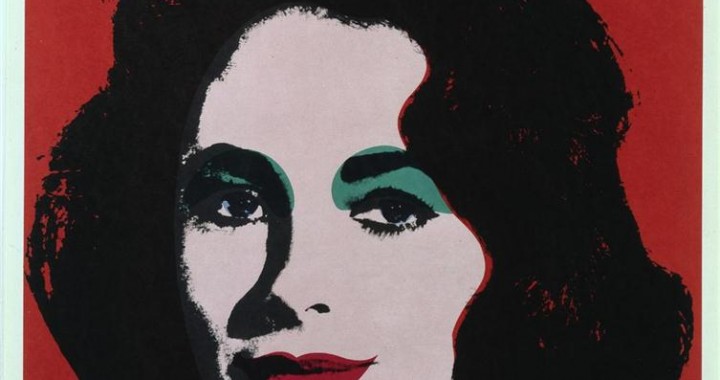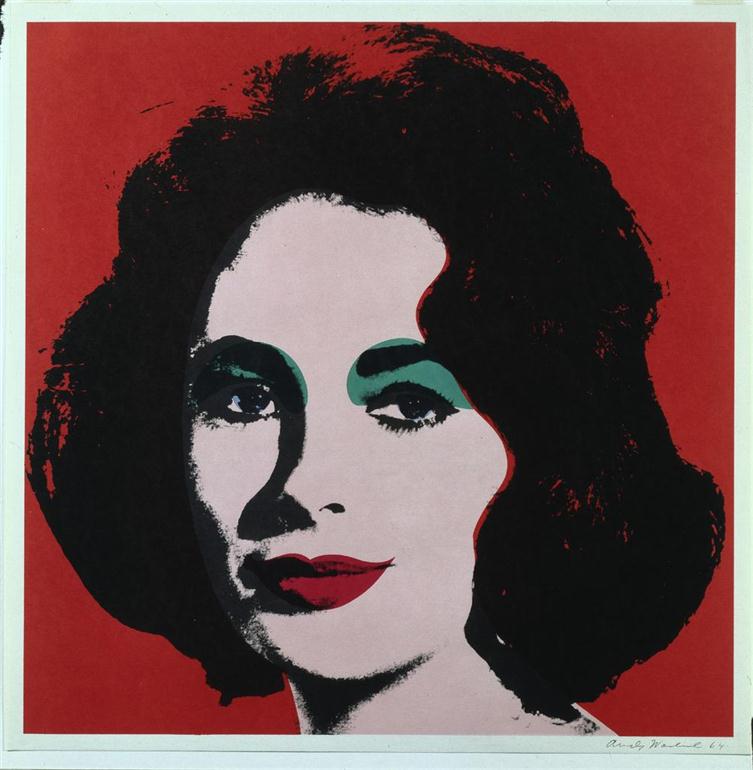
Liz, 1965 @ Andy Warhol Estate
A few minutes after we arrived, the silver door to the Factory opened and Andy Warhol stepped in to offer us an inanimate handshake.
Inside Andy Warhol
By Sterling McIlhenny and Peter Ray
The following interview with Andy Warhol appeared in the men’s magazine, Cavalier, in 1966.
To conduct the interview that follows we took our tape recorder to the “Factory,” as Warhol calls his studio, which is located on the fourth floor of a rickety loft building in Manhattan’s east forties. The interior of the Factory – walls, ceiling, and floor – and everything in it, is painted silver or covered with a veneer of Reynolds Wrap – which produces a curiously timeless, abstract feeling. About the only furniture, aside from a few props left over from movie-making, is a couple of pieces in the 1930’s ‘moderne’ style – a lucite-and-glass china cabinet and the semi-circular couch on which we conducted the interview. In the center of the Factory six or seven youths, male and female, all sporting tight pants and long hair, were languidly frugging to the Beatles’ latest number, blasting from a loudspeaker.
A few minutes after we arrived, the silver door to the Factory opened and Andy Warhol stepped in to offer us an inanimate handshake. Except for his hair, which, like the interior of the Factory, seems to sport an applied silver color, Warhol creates a completely unobtrusive presence. He is pale and slight. He uses few gestures, speaks softly, sometimes almost inaudibly, and wears dark glasses indoors and out. It is almost impossible to tell whether the aura of bland self-concealment that surrounds him is a mask assumed to create a paradox or, true paradox, is simply like the real man himself.
This interview may be read as a Pop Art psychodrama. The cast of characters includes, besides the subject, a number of Assistants to the Artist, who, abandoning the Beatles, draped themselves around our couch.
Before we could get our tape recorder warmed up, Andy Warhol produced his own transistorized set and placed the microphone before us.
Andy Warhol: Have you ever been taped before?
Cavalier: No. At any rate not as a part of the underground movement.
Andy Warhol: We should make a video tape of this interview at the same time so we could look at it.
Cavalier: This is a very interesting looking place, although the Reynolds Wrap seems to be coming loose here. Is there any particular meaning behind everything being painted silver?
Andy Warhol: Well, you might say I have a fondness for silver, or even gold for that matter.
Cavalier: The gold seems to be well hidden. Where did you get this cellophane-wrapped couch?
Andy Warhol: It just arrived one day. Apparently someone made a mistake in the address and had it delivered here.
Cavalier: You didn’t tell them it was a mistake?
Andy Warhol: No. We didn’t want them to have to move something that heavy again after they’d already brought it here.
Cavalier: About when did the Pop Art movement begin?
Andy Warhol: I guess about five years ago.
Cavalier: Salvador Dali has been quoted as saying that he is the father of Pop Art. Have you any comment on that?
“He’s (Dali) certainly been around a long time. But it’s hard to understand what he is saying most of the time.”
Andy Warhol: I don’t know. He’s certainly been around a long time. But it’s hard to understand what he is saying most of the time.
Cavalier: What were the first Pop Art things you did?
Andy Warhol: I did comic strips and ads. A great many artists were working on different ideas at the same time. Things just fell together to create the Pop Art movement.
Cavalier: Why did you start with comic strips? Were you interested in them as an entertainment medium or, as some intellectuals regard them, a kind of illustrated modern mythology?
Andy Warhol: I don’t know. Just as comic strips, that’s all. They were things I knew and they are relatively easy to draw or, better still, to trace. I also did movie stars – Marilyn Monroe, Elizabeth Taylor, Troy Donahue – during my ‘death’ period. Marilyn Monroe died then. I felt that Elizabeth Taylor was going to die too, after her operation. I thought that there were a lot of people who were going to die – like Troy Donahue.
Cavalier: Why did you think Troy Donahue was going to die?
Andy Warhol: I don’t know. He just looked like it. I concentrated on a series of Marilyn Monroe. She fascinated me as she did the rest of America. I did about forty paintings of her. Most of them are in gallery shows and private collections. But I still have some of them myself.
Cavalier: Are they all different?
Andy Warhol: Most of them are. I used photographs. I made multiple-color silk screen paintings – like my comic strip technique. Why don’t you ask my assistant Gerry Malanga some questions? He did a lot of my paintings.
Cavalier: Mr. Warhol, what’s your role in making the paintings?
Andy Warhol: I just selected the subjects, things that I didn’t have to change much.
Cavalier: With such a lack of involvement in your own work, what value if any could your painting hold for you?
Andy Warhol: Oh, I don’t know… (At this point a lanky, wavy-haired young man dressed in short pants, sandals, and sun glasses appeared in the silver entrance to the Factory.) Oh! Ondine does some of my Pop Art work. Come here, Ondine, we’re being taped. Just a few words.
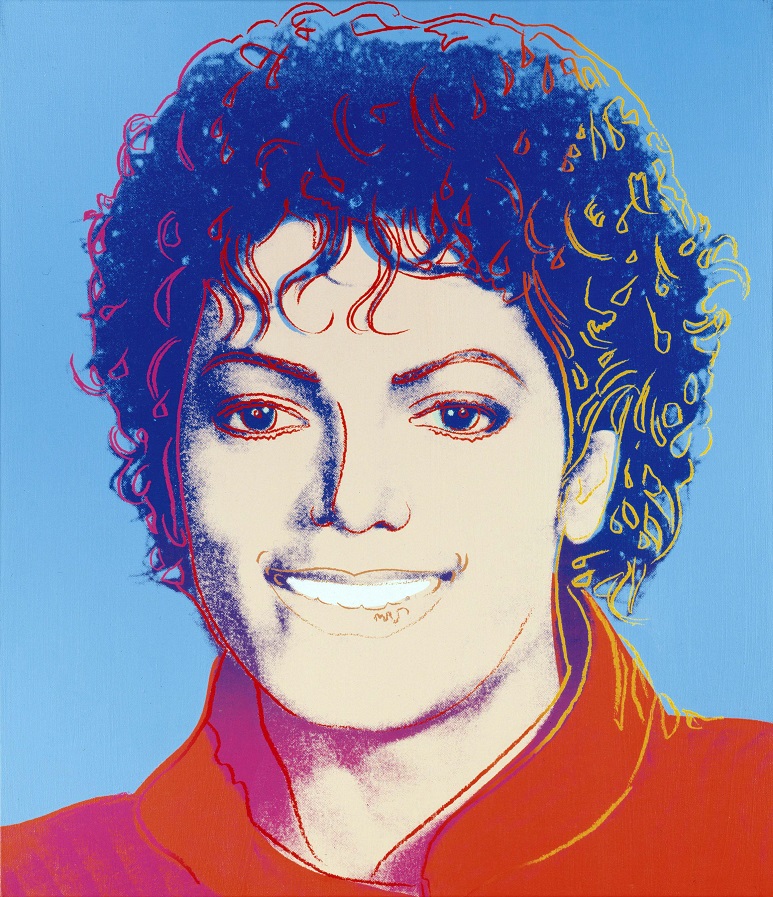
Michael Jackson, 1984 @ Andy Warhol Estate
Ondine: I have to go to the bathroom first.
Andy Warhol: Oh, no, come here first.
Cavalier: Do you have any feeling at all about the images you create?
Andy Warhol: Ondine, you’re not going to the bathroom.
Cavalier: By the way, you have a great mirror in there. It’s very narcissistic.
Andy Warhol: Really? Where is it? I don’t remember.
Cavalier: Behind the door. It gives you a two-way view of yourself using the toilet. But let’s get back to art. Most of the things you paint are simply exact re-creations – rather than interpretations – of perfectly ordinary things: Brillo boxes, dollar bills, matchbook covers. Some are recognizable as art only because they are displayed in a gallery instead of a supermarket. When you paint these objects do you have a specific audience in mind?
Andy Warhol: No.
Cavalier: What is your feeling then? Do you want anyone to react to them, or do you paint them just to please yourself?
Andy Warhol: It gives me something to do.
Cavalier: As opposed to what? Nothing to do?
Andy Warhol: Yes.
Cavalier: There must be more rewarding things to do than printing dozens of Brillo labels by hand. It must take a great deal of time and effort.
Andy Warhol: It doesn’t take long, especially when you have a lot of people helping you.
Cavalier: Do you expect people to regard them as works of art?
“No, we don’t have any feeling about them (paintings) at all, even when we are doing them.”
Andy Warhol: No, we don’t have any feeling about them at all, even when we are doing them. He’s certainly been around a long time. But it’s hard to understand what he is saying most of the time.It just keeps us busy. It’s something to pass the time.
(Ondine comes out of the bathroom.)
Andy Warhol: Oh, Ondine – don’t disappear again. Please.
Cavalier: Why is Ondine emptying a bucket of water into the toilet?
Andy Warhol: It’s very important. The toilet doesn’t work very well.
Cavalier: To return to the fine arts: Why do people buy your art?
Andy Warhol: I don’t know.
Cavalier: Isn’t there a slight chance that you’re trying to find out just how far the public will follow your artistic experiments?
Andy Warhol: No. It just gives me something to do.
Cavalier: Have you ever met anyone who has bought your work?
Andy Warhol: Just one – and they keep sending it back without paying for it. Usually for personal reasons.
Cavalier: What do you mean? That they’ve hung it wrong or you don’t like it?
Andy Warhol: No. They just keep sending it back. It’s not the price. They can afford the money. Oh! Ondine. Please say a few words. Come on.
Ondine: When shall I ever get to bed?
Andy Warhol: Just sit right here next to me.
Ondine (To Cavalier): Hello. How are you? What’s that (indicating microphone)?
Cavalier: That’s Warhol’s – this is ours (microphone) – the real taping.
Ondine: Then I’ll talk into Warhol’s.
Andy Warhol: Ondine was the subject of my six-and-a-half-hour movie Sleep. He was the only thing on camera for the entire film. [Note: The real star of Sleep was, of course, John Giorno. gc.]
Cavalier: Ondine, then, is living, walking subject matter.
Andy Warhol: Well, walking, yes.
Ondine: I am just walking: I have a terrible cold. I haven’t been able to sleep in almost three days.
Cavalier: Is Ondine a Pop artist?
Andy Warhol: No, but he does some sculpture. What would you say, Ondine?
Ondine: I hope people never will buy anything that I do. I never want to be popularly accepted. For instance, I won’t appear in any movies other than Andy Warhol’s, and they aren’t popularly accepted.
Cavalier: Does he pay you?
Ondine: Of course not. I do it for love.
Cavalier: Why, again, Mr. Warhol, do you think people go out and buy a brillo box painted by you when they can just as well buy the real thing for a few cents, if they regard this as art?
Andy Warhol: They could get SOS, the rust-free soap pads. Ondine, what kind do you use?
Ondine: I use any kind that will give my complexion that fresh scrubbed look. Sunkist like a lemon.
Andy Warhol: I thought your mouth was sunkist.
Ondine: My mouth? Oh, no. That’s a dew drop.
Andy Warhol: Somebody get Ondine a glass of water.
Cavalier: Ondine, do you like other people’s Pop Art?
Ondine: I don’t know other people’s Pop Art. I only know Andy’s.
Cavalier: That’s hard to believe. Mr. Warhol, have you, like many other artists today, ever been in analysis, or taken any hallucinogenic drugs?
Andy Warhol: No, I think I face everything straight on.
Cavalier: Do you think this is reflected in your painting?
Andy Warhol: I think it is. Ondine, do you like the magic book I gave you? Are you a witch, Ondine?
Ondine: Yes, I do like the book but I couldn’t be a witch, I’m not from the Bronx.
Cavalier: Do you have to be from the Bronx to be a witch?
Ondine: All the witches I’ve met are from the Bronx.
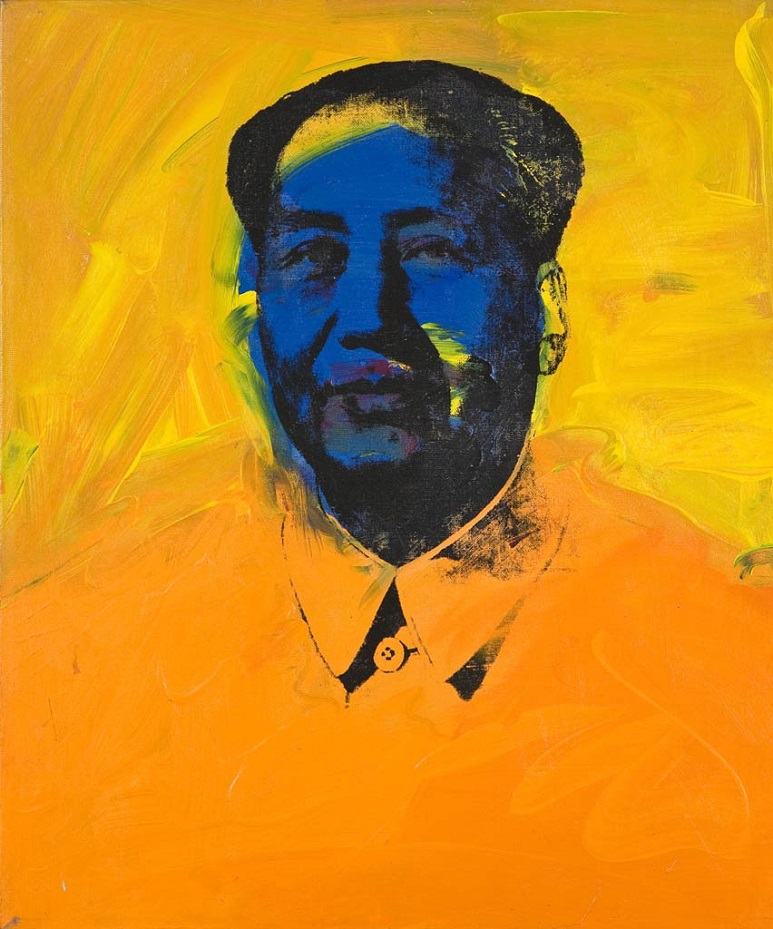
Mao, @ Andy Warhol Estate
Cavalier: Mr. Warhol, did you ever study art?
Andy Warhol: No I never did, but Ondine did in High School.
Ondine: Yes, but I only paint myself. White. With water-soluble paint. I was at Henry Geldzahler’s and he was painting the bathroom. I got some paint on myself and decided to take my clothes off and paint myself all over. Then he took the brush away from me.
Cavalier: Mr Warhol, you just said that you hadn’t studied painting. Has there been a strong influence in your work?
Andy Warhol: Mark [sic] Chagall. I love his work very much. I never had any thought of copying his art, but I did feel that I could express my ideas as he has.
Cavalier: When did you start painting?
Andy Warhol: About four or five years ago.
Cavalier: What about the time prior to that?
Andy Warhol: Before that time I was very young.
Cavalier: Yes. I’m sure you were. Are you interested in what the critics say about your work?
“Whatever anyone else says has no value to me concerning my work. I don’t need approval.”
Andy Warhol: No, just Henry Geldzahler. He’s a good friend – a fan. And I want him to care. Whatever anyone else says has no value to me concerning my work. I don’t need approval. I have confidence in what I’m doing.
Cavalier: What is the future of Pop Art?
Andy Warhol: It’s finished.
Cavalier: What will you do?
Andy Warhol: I’ll become more involved in my movies. I haven’t done any painting since May of last year.
Cavalier: Have you made any money from your paintings?
Andy Warhol: Yes. But it just covers the cost of making movies. I don’t pay any of the people who act in them or help conceive the ideas, but film and processing cost a lot, and the rent of the Factory and the props.
Cavalier: Could you tell us something about your movies?
Andy Warhol: It would take too long. There are over forty of them.
Cavalier: Film Culture magazine has said that your “Underground” movies are a “meditation on the objective world, in a sense… a cinema of happiness.” Some of your films, however, are about rather bizarre aspects of the objective world. For example, Eat is forty-five silent minutes of a man eating a mushroom, Empire is eight solid hours of the world’s tallest building. blow Job has been described as one half hour of ‘a passionate matter handled with restraint and good taste.’ One of your newest sound films, Vinyl, has a couple of scenes of what the Victorian english referred to as ‘buggery,’ a subject which, by any name, is still regarded rather gravely by polite society. In view of such controversial subjects, have you ever encountered any trouble showing your films?
Andy Warhol: In the past there has ben at least one bad scene I can recall – a police raid. But I think they’ve about gotten over this by now.
Cavalier: When did you first start making movies?
Andy Warhol: About two years ago. I just suddenly came up with the thought that making movies would be something interesting to do, and I went out and bought a Bolex 16mm camera. I made my first movie in California, on a trip to Los Angeles. I went there with Taylor Meade [sic], an Underground movie star. We stayed in a different place every day. We took some shots in a men’s room out at North Beach and we used one of the old Hollywood mansions for for some of the inside shots. The movie we were shooting was Tarzan and Jane Regained Sort of. Taylor Meade [sic] called it his most anti-Hollywood film. [Note: Tarzan and Jane was not Warhol’s first film – see filmography. gc.]
Cavalier: Where do you show them?
Andy Warhol: They were showing one at the Cinematheque the other night. And they play at the Astor Playhouse.
Cavalier: Is there any relation between your paintings and your movies?
Andy Warhol: No, but there will be. Henry Geldzahler said I could combine my movies and my paintings.
Cavalier: What do you mean?
Andy Warhol: I don’t think I should go into details right now.
Cavalier: Who besides Ondine has played in your films?
Andy Warhol: Baby Jane used to . Edie Sedgwick is our new superstar.
Cavalier: Where do you make your movies?
Andy Warhol: Nearly all of the indoor shots can be done here in the Factory, as the props are very stark, almost severe. The outdoor shots are done wherever we feel like doing them. In the beginning when we first started with film we went about it in the traditional way technically. They were cut and edited as any other films are. We’ve given that up now. We feel we’re beyond that.
Cavalier: Not long ago you were experimenting with video tape. In fact you said you might do all your future work with tape.
Andy Warhol: Well, yes, we were working with some equipment form the Norelco people. It was all here at the Factory, and as you can see, it’s gone now. They made a promotional thing of it including an underground party on the railroad tracks underneath the Waldorf Astoria, down where the tracks run towards Grand Central Station. It was climaxed by the filming of a duelling scene. Video tape has its advantages, such as immediate playback and you can get by with very little light. It allows for instant retakes and with this you can maintain the particular mood that has been created for a scene.
Cavalier: You must have some sort of crew for making these movies.
Andy Warhol: Well I do, and then there are two secretaries for correspondence and answering on the phone and changing records on the phonograph.
Cavalier: What movie are you doing now?
Andy Warhol: We are doing a movie called Breathe, and after that we’ll do a movie a week, but they’ll be straight movies.
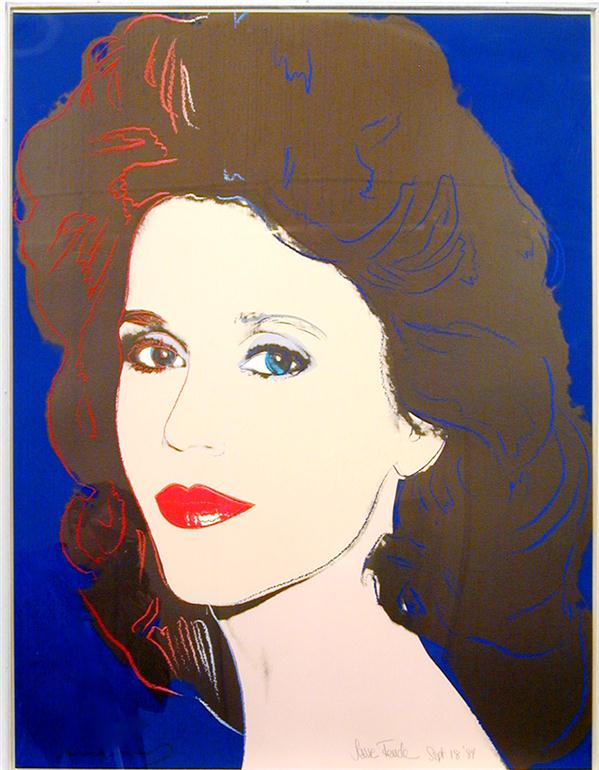
Jane Fonda, @ Andy Warhol Estate
Cavalier: What do you mean by ‘straight’ movies?
Andy Warhol: I can’t define it – Let’s just say something that ‘s not vacuous.
Cavalier: Do you have any particular person in mind for these movies?
Andy Warhol: Edie Sedgwick will be in all of them.
Cavalier: In 1964, when she was named ‘Girl of the Year,’ Baby Jane appeared in many of your movies. Do you think her parts in your films had anything to do with her other successes?
Andy Warhol: Oh, yes. She really hadn’t done anything until she joined our group.
Cavalier: How did that come about?
Ondine (interrupting): She just appeared here one afternoon. She was swept in by a group of fairies and then decided to come back every now and then.
Cavalier: Do you have fun making your movies?
Andy Warhol: Oh, yes, I enjoy it.
Cavalier: Even the one showing Ondine sleeping for over six hours?
Andy Warhol: Well, I’ve never watched all of that one. I just fed film into the camera and made sure it was taking the pan shots and other shots that I wanted. In the end, thought, we only used 100 feet of the film we shot, running it over and over again for eight hours. We don’t edit any of the films. What I sometimes do is use two reels of the three reels we may have shot. [Note: Sleep was actually edited fairly extensively by Sarah Dalton according to Warhol’s instructions.gc]
Cavalier: Do you want a lot of people to see your films?
Andy Warhol: I don’t know. If they’re paying to see them. By the way, they can be rented. There’s a catalog, and the cost is nominal: one dollar per minute. A 30-minute film can be rented for $30. Sleep rents for $100, at a special rate, and you can get all eight hours of Empire for $120.
Cavalier: A lot of people have said that these are pretty boring films.
Andy Warhol: They might be. I think the more recent ones with sound are much better.
Cavalier: You say you are not going to continue painting in order to concentrate on movie-making. Is there any one particular reason for this?
Andy Warhol: I decided to concentrate entirely on films when I met the most fantastic man in the world, Huntington Hartford. He is very enthused about what we are trying to do. He has offered us the use of his Paradise Island in the Bahamas to make our next film.
Cavalier: Knowing the kind of conservative art that is shown in Mr. Hartford’s Gallery of Modern Art it is hard to imagine him taking part in such an avant-grade venture.
Andy Warhol: Well, along with everyone else he is very excited about this project. It’s to be our first full-length picture. By that I mean it will have a large cast and a complete crew of technicians and a carefully prepared script.
Cavalier: What will distinguish this from your other films besides the large cast and crew?
Andy Warhol: We plan to make money from it. Not just enough to cover the rent here at the Factory and the cost of processing films but a good deal of money.
Cavalier: Can you tell us something about this film?
Andy Warhol: It will be Jane Eyre. Chuck Wein is writing the shooting script. We know we want a total running time of one hour and forty minutes and that Edie Sedgwick will be the star. Why don’t you ask Chuck some questions.
Cavalier: How do you do, Mr. Wein? How did you get involved with Andy Warhol?
Chuck Wein: It was an accident. I was at a party with Edie and Andy asked me if I’d like to write a movie for him. I said yes. So far I’ve done Poor Little Rich Girl, Party, It Isn’t Just Another Afternoon, and some others.
Cavalier: Mr. Warhol, why did you pick Chuck as a script writer?
Andy Warhol: When I met him at the party I couldn’t think of anything else to say.
Cavalier: The average person may not know much about art, but if he follows the gossip columns and watches the ‘night’ shows on television, he knows something about you. For example, recently a photograph appeared in the society sections of the New York papers of you and Edie Sedgwick at a ‘Mod Ball’ at the Rainbow Room in Rockefeller Center. You have become a real social phenomenon, in a peculiar sense.
Andy Warhol: The part about the parties I attend is probably overplayed. Most of them are well covered by the press. That accounts for my name appearing so often. I’ve been on some radio and television shows, but I usually bomb out. I’ve given up saying anything.
Cavalier: Anything?
Andy Warhol: Just about.
[end.]
(All rights reserved. Images @ Andy Warhol Estate)
